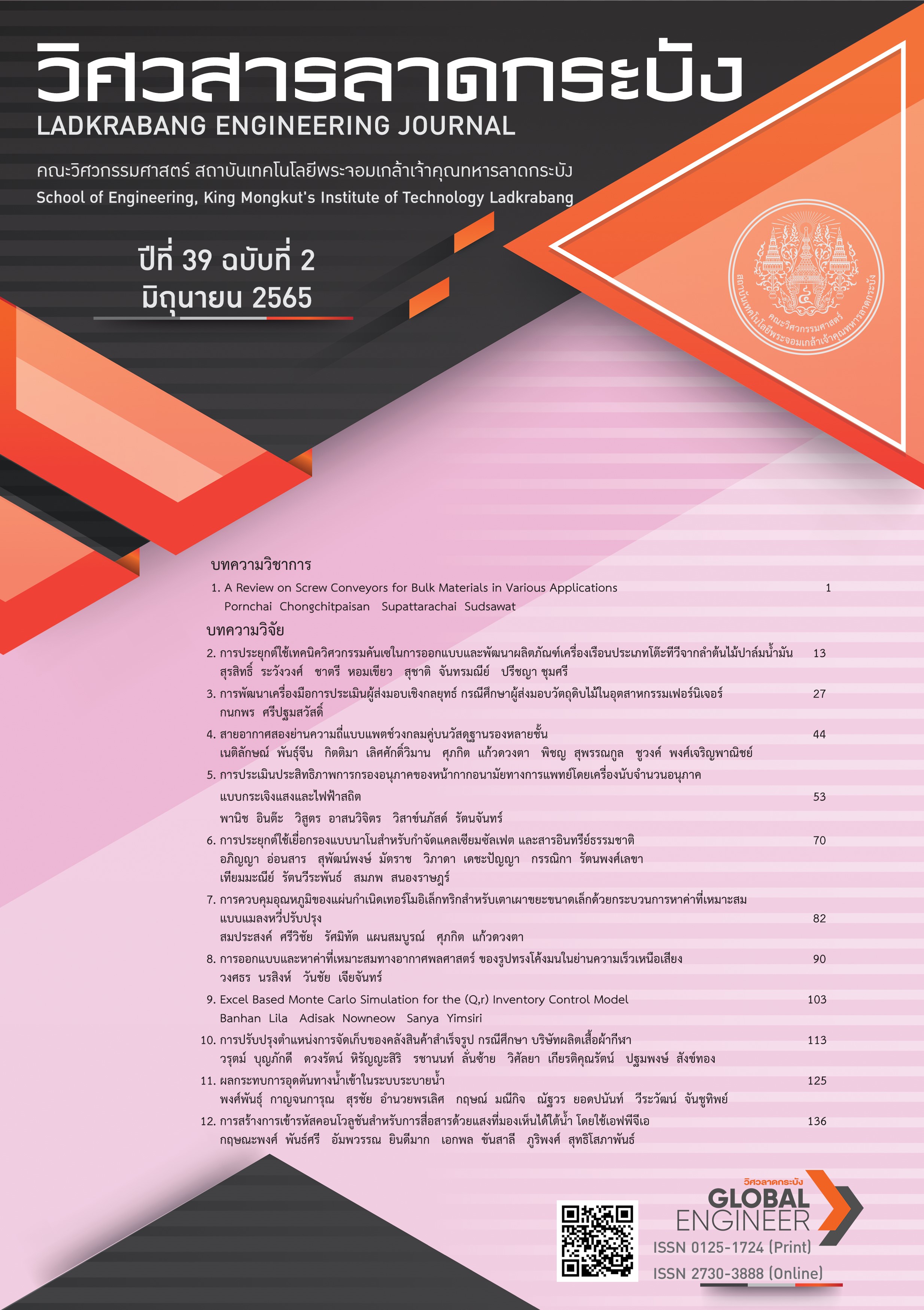FPGA Implementation of Convolutional Code for Underwater Visible Light Communication Systems
Keywords:
underwater communication, visible light communication for sending pH and temperature values, convolutional code using field programmable gate arrayAbstract
In this work, the error-correcting code, namely convolutional code, is developed and implemented using field-programmable gate array (FPGA) is proposed for underwater visible light communication (UVLC). The Viterbi decoding using the trellis diagram is used. The transmitter is located underwater with 10w LED and the baud rate is 9,600 b/s, which is compatible with the UART communication protocol. Four avalanche photodiodes with a bandwidth of 25 MHz is used to convert the light signal to an electrical signal at the receiver. Additionally, the output signal from the APDs is amplified by using OPA2380. The input voltage target is 3.3v, which is suitable for the ESP8266. Additionally, the measured data send to NETPIE for presented on the website in the following. To verify the system performance, the measurement data is recorded for 240 minutes with a communication distance of 1.45m. The bit error rate is 1.4 × 10 -3; therefore, the system can correct the error and show it on NETPIE correctly. The data is measured in real-time.
References
H. Kaushal and G. Kaddoum, “Underwater optical wireless communication,” IEEE Access, vol. 4, pp. 1518–1547, 2016, doi: 10.1109/ACCESS.2016.2552538.
T. Szili, B. Matolcsy and G. Fekete, “Water pollution investigations by underwater visible light communications,” in The 17th International Conference on Transparent Optical Networks (ICTON), Budapest, Hungary, 2015, pp. 1–4, doi: 10.1109/ICTON.2015.7193516.
S. Watson, S. P. Najda, P. Perlin, M. Leszczynski, G. Targowski, S. Grzanka, M. A. Watson, H. White and A. E. Kelly, “Multi-gigabit data transmission using a directly modulated GaN laser diode for visible light communication through plastic optical fiber and water,” in 2015 IEEE Summer Topicals Meeting Series (SUM), Nassau, Bahamas, 2015, pp. 224–225, doi: 10.1109/PHOSST.2015.7248278.
K. Nakamura, I. Mizukoshi and M. Hanawa, “Optical wireless transmission of 405 nm, 1.45 Gbit/s optical IM/DD-OFDM signals through a 4.8 m underwater channel,” Optics Express, vol. 23, no. 2, pp. 1558–1566, 2015, doi: 10.1364/OE.23.001558.
S. Andreas, C. Olivier, S. Bruno, C. Tobias, S. Arne and G. Seabear, “Underwater monitoring system for body temperature and ECG recordings,” Underwater Technology, vol. 34, no. 3, pp.135–139, 2017, doi: 10.3723/ut.34.135.
K. Puntsri, E. Khansalee and P. Suttisopapan, “Underwater environment sensors with visible light communication systems,” Journal of Current Science and Technology, vol. 11, no. 2, pp. 269–276, 2021, doi: 10.14456/jcst.2021.27.
Z. Decai, L. Xiaochun, W. Haitao and X. Jinsong, “Implementation of convolutional code based on FPGA in OFDM-UWB system,” in The 2008 3rd IEEE Conference on Industrial Electronics and Applications, Held, Singapore, pp. 1119–1122, 2008, doi: 10.1109/ICIEA.2008.4582692.
B. Sklar, “Channel Coding: Part2,” in Digital communications: fundamentals and applications, Hoboken, NJ, USA: Prentice Hall, 2001, ch. 7, sec. 7.1, pp. 381–435.
W. C. Cox, J. A. Simpson, C. P. Domizioli, J. F. Muth and B. L. Hughes, “An underwater optical communication system implementing Reed-Solomon channel coding,” in OCEANS 2008, QC, Canada, 2008, pp. 1–6,doi: 10.1109/OCEANS.2008.5151992.
J. Zhang, Y. Yang, Z. Gao, Y. Zhu, “Performance analysis of LDPC codes for wireless optical communication systems in different seawater environments,” in 2018 Asia Communications and Photonics Conference (ACP), Hangzhou, China, 2018, pp. 1–3, doi: 10.1109/ACP.2018.8596282.
G. S. Spagnolo, L. Cozzella and F. Leccese, “Underwater optical wireless communications: overview,” sensors, vol. 20, no. 8, pp. 1–14, 2020, doi: 10.3390/s20082261.
M. Jahanbakht, W. Xiang, L. Hanzo and M. Rahimi Azghadi, “Internet of underwater things and big marine data analytics—a comprehensive survey,” IEEE Communications Surveys & Tutorials, vol. 23, no. 2, pp. 904–956, 2021, doi: 10.1109/COMST.2021.3053118.
B. Cochenour, K. Dunn, A. Laux and L. Mullen, “Experimental measurements of the magnitude and phase response of high-frequency modulated light underwater,” Applied Optics, vol. 56, no. 14, pp. 4019–4024, 2017, doi: 10.1364/AO.56.004019.
Downloads
Published
How to Cite
Issue
Section
License
Copyright (c) 2022 Faculty of Engineering, King Mongkut’s Institute of Technology Ladkrabang

This work is licensed under a Creative Commons Attribution-NonCommercial-NoDerivatives 4.0 International License.
The published articles are copyrighted by the School of Engineering, King Mongkut's Institute of Technology Ladkrabang.
The statements contained in each article in this academic journal are the personal opinions of each author and are not related to King Mongkut's Institute of Technology Ladkrabang and other faculty members in the institute.
Responsibility for all elements of each article belongs to each author; If there are any mistakes, each author is solely responsible for his own articles.






